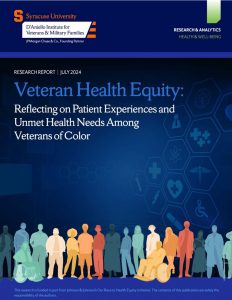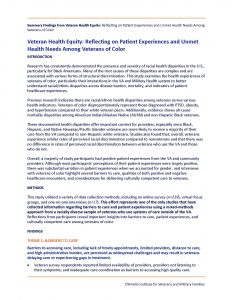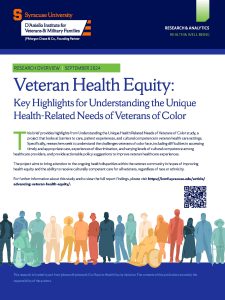With support from the Johnson & Johnson’s Our Race to Health Equity, Syracuse University’s D’Aniello Institute for Veterans and Military Families (IVMF) launched a research effort to gather insights on racial/ethnic disparities in healthcare access, quality of care and patient experiences, and health outcomes among veterans. This initiative is designed to address the critical gaps in our understanding of access to care and patient experiences across various care settings to promote health equity among veteran communities.
Key Insights from Veterans of Color
This effort represents one of the only studies that have collected information regarding barriers to care and patient experiences using a mixed-methods approach from a racially diverse sample of veterans who use systems of care outside of the VA. Findings below are based on data from 219 veteran survey respondents and 17 focus group participants that identified as veterans of color.
1
Barriers to Care
2
Patient Experiences
3
Culturally Competent Care
Key Insight 1: Barriers to Care
Barriers to accessing care, including lack of timely appointments, limited providers, distance to care, and high administrative burden, are perceived as widespread challenges and may result in veterans delaying care or experiencing gaps in treatment.
- Veterans of color who participated in the interviews described their difficulties accessing timely care as a “systemic” problem related to VA resource constraints, rather than attributing barriers to care to their race or racism.
- 1 in 5 Veterans of Color considered access to VA health care services as a top factor in deciding where to live after their military service, but 15% indicated that they live too far from the nearest VA as the top reason for not receiving their care from the VA.
Veterans of Color Respondents
Non-Hispanic White Respondents
Key Insight 2: Patient Experiences
Veterans consider a range of factors when evaluating the quality of their patient experiences and healthcare.
- Veteran of color interviewees noted clear communication, timely appointments, and access to Complementary and Alternative Medicine (CAM) as attributes of their positive healthcare interactions.
- Veteran of color interviewees cited difficulty obtaining timely appointments, dismissive providers, rude administrative staff, record sharing constraints, complex referral practices, and insistence on prescribing pharmaceutical interventions as characteristics of poor healthcare interactions.
of veteran of color survey respondents agree that their VA provider gives them the necessary resources and/or information to understand and manage their health.
Key Insight 3: Culturally Competent Care
- Factors for consideration in delivering culturally competent care vary situationally, by individual, and may or may not include race as a salient or dominant factor for consideration.
- Veterans of color, especially women, have implemented strategies that confront veteran, racial, and gender stereotypes. Veterans of color who participated in the interviews described changing their voice, adjusting their physical appearance, and being overly apologetic or polite during interactions with their medical providers or their staff.
- Some veterans of color who participated in interviews explained that they intentionally seek care from providers with prior military service experience or experience working with military and veteran communities or those with underrepresented identities or from historically underserved communities (e.g., racial/ethnic or gender minorities) to feel more understood by their providers.
Recommendations to Advance Health Equity for Veterans
1
Improve access to care
2
Enhance cultural competency
3
Support veteran agency
4
Conduct further research
Below: The front of the tiles provides real challenges shared by veterans. You can hover over the tiles to see the suggested solutions aimed at advancing veteran health equity.



